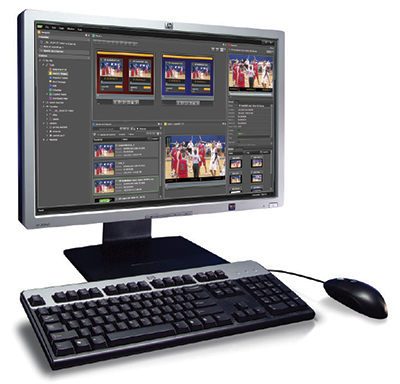Asset Management Increases Its Role in Production

Grass Valley Stratus
OTTAWA—Digital asset management began as a file-based alternative to managing physical videotape media. Today, it has become much more: Broadcasters now rely on asset management systems or digital content management to help them manage the end-to-end content process. DAM systems are ingesting video from various sources, allowing simultaneous access to it by different editors, and playing content encoded into various video formats on air, the Web, and mobile. In doing so, DAM systems are boosting production capabilities while reducing manpower and equipment costs, truly allowing broadcasters to do more with less.
The result: “Asset management systems have become the lifeblood of the broadcast enterprise,” said Shawn Kelly, senior director of media operations for Shaw Media in Canada. Shaw Media manages the terrestrial Global Television Network and 17 national cable channels centrally in its Toronto playout center. “We’ve migrated our cable channels to file-based workflows, and our Dalet MAM system is the heart of the workflow,” he said.
DAM systems are clearly proving their worth to broadcasters. But not everyone agrees that DAMs are “the heart of the workflow,” and others question if they should be allowed to gain such pivotal status.
DAM’S GROWING INFLUENCE
There is no doubt that a properly installed DAM system saves broadcasters money and resources while improving operational efficiency. This is because DAM can provide an end-to-end content management system that is centralized, logical, and integrated with other critical functions such as billing and traffic.
In the case of Shaw Media, “content is ingested under MAM control to our nearline and on-air servers and proxies are shared throughout the business,” according to Kelly. “MAM manages priorities by organizing jobs by air date, submits content to transcoders or automated file analysis and presents a queue for manual QC according to predetermined criteria. Completed files are submitted to play-out automation, HSM and to nonlinear destinations according to fields preselected on the work order form.”
Shaw Media isn’t alone in adopting a DAM system. Among broadcasters worldwide, “we are seeing a fundamental shift in the requirement to automate file-based workflows and associated asset management around those workloads,” said Neil Maycock, chief architect with U.K.-based Snell. “This is because traditional ways of handling content can’t cost-effectively scale to meet the challenge of serving multiple formats and platforms the way automated file-based DAM systems can.”
The professional video industry's #1 source for news, trends and product and tech information. Sign up below.
WHERE DOES IT FIT IN?
Developers of DAM systems acknowledge the growing importance of asset management in broadcast and are offer products to meet this increased demand. Where they differ is on their views of where DAM should fit into an end-to-end content management system, and whether DAM should be allowed to drive broadcast operations as a whole.

Ryan O’Quinn of Shaw Media uses a Dalet MAM system to manage media operations. “DAM systems are important as the front-end of an overall broadcasting management platform,” said Brian Campanotti, CTO of Denver-based Front Porch Digital, a maker of content storage management solutions. “And yes, they are able to serve as a user-facing hub, because of their ability to integrate with billing, scheduling, and traffic systems at the metadata level, and to link previously isolated content storage management repositories in news, sports, and commercial production,” Campanotti said.
That said, “I wouldn’t overstate DAM’s importance in overall broadcast management,” warned Mark Darlow, Harris Broadcast’s senior portfolio product manager, automation and digital asset management. “Traffic and automation play equally important roles in the process. It’s workflow that is king, not DAM.”
“We don’t believe the industry needs complicated and expensive MAM applications,” said Harold Vermeulen, senior vice president of product management for Grass Valley in San Francisco. “Digital content management is an essential component of end-to-end workflow, but it could be affordable and easy to deploy and use if we properly address the filebased workflow infrastructure with a solution like Grass Valley’s Stratus.”
ERP APPROACH
For French asset management companies Dalet and ProConsultant Informatique, DAM is central to the broadcasting management process; so much so, that it is central to their ERP-style products for broadcasters.
Short for “enterprise resource planning,” ERP is a single, centralized management software solution that manufacturers use to manage factories that make washing machines, sneakers, and chewing gum.
“We believe in managing broadcast operations on an end-to-end basis, so much so that we are introducing the new Dalet Galaxy at NAB 2013,” said Kevin Savina, Dalet’s director of product management. “Dalet Galaxy is our latest MAM-based platform that integrates with and unifies all the different systems in the production/distribution chain. It also manages the media and metadata across all those systems.”
Hervé Obed, ProConsultant Informatique’s founder and CEO says the company’s Louise business management software handles all aspects of a broadcast operation; not just content, traffic and billing but also linear and nonlinear rights. “The broadcast market is moving towards this kind of ERP management model, because it is the only way to rationalize the operations and investment in a broadcasting business,” he said.
Despite the debate, DAM systems are clearly growing in importance in broadcast management. This fact, plus the move towards broadcasting ERP solutions, signals an integrated, centralized future for broadcast management in the years to come.
James Careless is an award-winning journalist who has written for TV Technology since the 1990s. He has covered HDTV from the days of the six competing HDTV formats that led to the 1993 Grand Alliance, and onwards through ATSC 3.0 and OTT. He also writes for Radio World, along with other publications in aerospace, defense, public safety, streaming media, plus the amusement park industry for something different.

